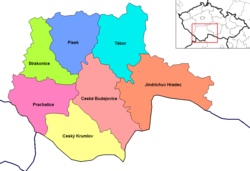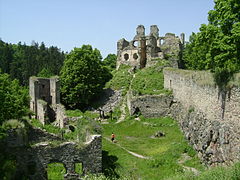South bohemia (Czech: Jihočeský kraj, spoken: jihotschäskii kraj, IPA: [jihɔt͡ʃɛskiː kraj]) is the part Bohemiawhich stretches along the Czech border in the Bavarian Forest and along the Austrian border in the Bohemian Forest.

places


- Ceske Budejovice (České Budějovice), the largest city in South Bohemia, lies at the confluence of the Vltava, which is becoming navigable here, with the Malše in a flat, fertile area.
- Český Krumlov (Bohemian Krumau) is about 40 km southwest of Budweis on the Vltava River. Her castle is the second largest in Czech Republic and contains elements from the Gothic to the Baroque period. The architectural heritage of the old town has also been largely preserved and became a UNESCO World Heritage Site in 1992.
- Jihlava (Iglau) is located about 90 km southeast of Prague on the Jihlava River and is the capital of the administrative region of the Highlands (Vysočina), which is divided into the historical countries of Bohemia and Moravia. The well-preserved city center was declared an urban monument reserve in 1982.
- Jindřichův Hradec (Neuhaus) lies on a headland of the Nežárka and Hamerský potok. Jindřichův Hradec Castle is next to Prague Castle and the chateau in Český Krumlov one of the largest monuments in the Czech Republic.
- In Písek is the oldest stone bridge Czech Republic. But the third largest city in South Bohemia also impresses with a beautiful old town, the royal castle is also worth seeing.
- Prachatice (Prachatitz) with a beautiful city center on the Goldener Steig.
- Strakonice, The venue of the International Bagpipe Festival, is located at the confluence of the Otava and Volyňka rivers. A tourist highlight is the Baroque Střela Castle, 2 km from the town.
- Tábor is also interesting for tourists surrounded by a charming landscape. Tábor has a beautiful old town, but it is more medieval. The famous knight tournaments take place every year in September.
Other goals


- Moldau reservoir - The Lipno Reservoir (Údolní nádrž Lipno in Czech) is the largest lake in the Czech Republic, part of the Vltava Cascade (Vltavská kaskáda in Czech) and forms its fourth oldest and highest level. It is located on the border with Austria in the Bohemian Forest National Park and Protected Landscape Area (Czech Národní park a chráněná krajinná oblast Šumava) in the Okres Český Krumlov (Krumau district), only a small extension of the lake in the northwest is in Okres Prachatice (Prachatitz district), in the southwest a very small part of the Austrian territory (Rohrbach district, Upper Austria).
- Šumava National Park - The national park located in the Šumava Biosphere Reserve is the largest Czech Republic and is on the border with Germanywhere there is also the national park Bavarian forest is located. The Šumava Protected Landscape Area is one of the largest and most species-rich protected areas in Central Europe They represent a valuable natural area as well as a popular destination for tourism.
language
.jpg/250px-Chalupská_slať_1_(10).jpg)
The main language in South Bohemia is of course Czech. After Velvet Revolution In 1989, English and German were once again taught as a subject in schools.
getting there
By plane
The Ceske Budejovice airport, on which flight operations are to commence in 2020.[outdated] In the meantime, the nearest commercial airports are in Linz and Prague.
By train
The two most important railway lines in the district are Prague – Budweis – Linz, Budweis – Pilsen and the Budweis – Brno line, which is currently being upgraded (as of 2/17, there are always sections in the replacement rail service).
Of Vienna (Franz-Josefs-Bahnhof) you can take regional express trains to the border town of České Velenice (at Gmuend), from there you have connections to other important transport hubs (e.g. Ceske Budejovice, Třeboň). For example, it takes 3:20 hours from Vienna to Budweis. Regional express trains run from Linz (Jižní expres) to Budweis (travel time 2 hours) and Tábor (2:45 hours). In addition, there are even S-Bahn lines S 3 between Linz and Budweis (Danube Vltava), which are designated as regional trains (Os) on the Czech side. In cross-border traffic between Austria and the Czech Republic, inexpensive Euregio tickets from ÖBB are valid.
There is no direct rail connection from Bavaria to southern Bohemia. You have to change either in Linz or in Pilsen.
From Prague there are express trains every two hours and express trains every hour (slightly more intermediate stops) to Tábor (approx. 1:20 hours) and Budweis (2–2½ hours). From Pilsen there are express trains every two hours to Strakonice (1 hour), Budweis (1:55 hours), Jindřichův Hradec (3:10 hours). In the opposite direction there are trains from Brno and Jihlava, from where the journey to Ceske Budejovice takes 4:20 and 2:20 hours respectively.
By bus
Flixbus offers long-distance bus connections from Linz to Budweis (1:50 hours), from Vienna to Třeboň (3 hours), Budweis (3½ hours) and Český Krumlov (4 hours) as well as from Munich via Passau to Horní Planá in the Bohemian Forest ( 5½ hours), Český Krumlov and Budweis (6½ hours).
In the street
The road infrastructure in Czech Republic is currently being expanded significantly. One example is the highways D 3, which is to be led from Prague via Budweis to the Austrian border, as well as D 4which is to be run from Prague via Pisek. Also the European route E49 from Vienna by the Waldviertel to Budweis and Pilsen is already well developed in large parts.
mobility
The larger cities in the region are connected to one another by regional train lines.
The one founded by railway friends Jindřichohradecké místní dráhy (JHMD) operates the narrow-gauge railway lines Jindřichův Hradec – Obrataň and Jindřichův Hradec – Nová Bystřice.
Tourist Attractions
- historical town centers
- historical old town of Český Krumlov, UNESCO World Heritage Site
- Holašovice (16 km west of Budweis) - village with farms in the South Bohemian peasant baroque, UNESCO World Heritage Site
- historical city center of Tábor
- historical city center of Třeboň with castle and market square with Renaissance and Baroque town houses
- historical city center of Prachatice with listed houses from the 16th century and sgraffito facades
- Renaissance houses with sgraffito facades in Slavonice (on the Austrian border)
Baroque village Holašovice

Tábor market square
.jpg/271px-Trebon_Wittingau_(37899974104).jpg)
Třeboň market square

Rumpal House Prachatice
Sgraffito facades in Slavonice
- Palaces and castles
- 1 Hluboká nad Vltavou Castle (Frauenberg), 10 km north of Ceske Budejovice. Fairytale castle on the Vltava. The originally Gothic castle was converted into a Renaissance palace in the 16th century and completely rebuilt in the romantic style under Prince zu Schwarzenberg in the 19th century. Interior with fine woods, rich carvings and valuable furniture. The baroque hunting lodge Ohrada is only 2 km away.
- lock Jindřichův Hradec - Renaissance castle
- Červená Lhota Castle (Rothlhotta; 18 km northwest of Jindřichův Hradec) - an idyllic Renaissance moated castle; here were the fairy tale films the princess and the Pea (1977) and The key to happiness (1995) shot
- Zvíkov Castle (Klingenberg; 18 km north of Písek) - medieval royal castle, romantically situated on a water-washed peninsula at the confluence of the Vltava and Otava rivers
- Kratochvíle Castle (Kurzweil; 16 km northwest of Prachatice) - Renaissance castle in the style of an Italian country house
- Dívčí Kámen Castle (Maidstein; 12 km north of Český Krumlov) - ruins of a medieval spur castle
- monastery
- Zlatá Koruna Monastery (Goldenkron; 7 km northeast) - Cistercian monastery with architectural history from Gothic to Rococo and a valuable library
Hluboká nad Vltavou Castle

Jindřichův Hradec Castle
.jpg/271px-Cervena_Lhota_(38594034602).jpg)
Červená Lhota Castle

Zvíkov Castle
.jpg/271px-Schloss_Kratochvíle_(37743409915).jpg)
Kratochvíle Castle
Dívčí Kámen Castle
Zlatá Koruna monastery
activities
kitchen
A regional specialty is the Trdlo pastry, too Trdelník called. Originally it comes from the Slovakia and has the shape of a roll as it is baked on sticks. If you want, you can also bake grated nuts or cut it into small slices.
The Czech pastry Trdlo, also called Trdelnik
nightlife
security
climate
In general, the climate is relatively mild. In the higher areas, however, it is more humid and cooler, in valleys and basins warmer and drier.
Web links
- South bohemia on www.czechtourism.com
- South bohemia on www.czech-tourist.de



.jpg/271px-Trebon_Wittingau_(37899974104).jpg)





.jpg/271px-Cervena_Lhota_(38594034602).jpg)

.jpg/271px-Schloss_Kratochvíle_(37743409915).jpg)

,_Zlatá_Koruna_1_3.JPG/271px-Klášter_cisterciáků_Zlatá_Koruna_(Zlatá_Koruna),_Zlatá_Koruna_1_3.JPG)
